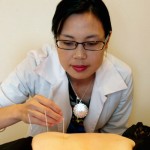BBC News 26 June, 2000
 The British Medical Association (BMA) says acupuncture should be made more widely available on the NHS. BBC News Online looks at the treatment.
The British Medical Association (BMA) says acupuncture should be made more widely available on the NHS. BBC News Online looks at the treatment.
There are two key methods of acupuncture – traditional Chinese and Western or modern approaches.
Complementary medicines originated in China, and countries including Egypt, around 3,000 years ago.
The Chinese system was developed on the basis of very detailed knowledge of herbal remedies combined with acupuncture.
Traditional Chinese Medicine
The Chinese approach regards the human body as a group of “energetic functions”, while the Western view is that it is based on body parts and their function.
Energy or “Qi” flows in an ordered way through 12 main meridians according to the traditional Chinese view. If the flow is interrupted, ill health results.
Acupuncture is thought to be a preventative form of medicine in some cases, perhaps even increasing resistance to infection.
When patients are already ill , acupuncture is said to stimulate the appropriate point along that affected channel so the Qi flow is restored.
Diagnosis is based on close examination of the patient’s tongue and pulse, the BMA says in its report on the therapy.
Western approach
The non-traditional version of acupuncture, the form usually practised in the UK, is based on neuroanatomy and physiology.
It considers the nervous, endocrine and immune systems to be “pathways” to pain.
Fewer needles are used than in the traditional Chinese method and they are left in the body for a shorter period of time.
“Trigger points” are thought to be areas of increased sensitivity within a muscle, which causes pain in a related part of the body.
Effectiveness
Clinical trials have shown acupuncture to be effective in relieving back and dental pain, migraine, nausea and vomiting.
It has not been shown to help with neck pain and evidence is not conclusive for recurrent headache, smoking and weight loss or stroke.
The BMA wants to know whether providing it on the NHS will be cost-effective.

 August 22, 2010 in
August 22, 2010 in 





